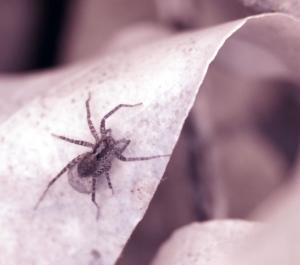An Interview with a Bio-Inspired Architect (Randy Anway)
In late June, Randy Anway was the first BID Community member to be interviewed about his views on the BID Community. The conversation covered a broad range of topics on the theory and practice of biomimicry. With 20 years experience in architectural systems analysis and design, Randy is currently a candidate for the Biomimicry Specialty Certificate Program from the Biomimicry Guild. In his spare time, he tries to express the unseen through digital photographs.
Norbert: How did you get started in biomimicry?
Randy: I read Janine's book some years ago but at the time did not see an opportunity to apply the concepts. I picked up the book again in 2007/2008, took advantage of education opportunities such as the 2009 Costa Rica Biomimicry Workshop and made contacts with the folks at CBID.
Norbert: What are your impressions on the current state of Biomimicry?
Randy: Biomimicry is still largely inspirational. It is difficult to incorporate biomimicry in day-to-day practice - architecture is always evolving but still relies heavily on 'tried and true' solutions. For me biomimicry is a long term developmental experience about identifying opportunities and lessons we can increasingly incorporate into human settlements through design and construction practice.
Norbert: How have you developed your interest in Biomimicry since 2009?
Randy: I am a proponent of Meadows' Leverage Points: Places to Intervene in a System, particularly the importance of changing mindsets. My goal is to help connect diverse groups who are moved towards more wisely adapting ourselves to our planet. Over time our lives could look and feel different in many desirable ways and that depends on what we do in the extended present. At the moment, the rate of adoption is slow. We still have hurdles to overcome before we can expect big changes.
Norbert: What do you see as the biggest challenges?
Randy: Finding the differences that make a difference, to quote Gregory Bateson. Some of the messages are getting through, there are a wide variety of voices and we lack unity and cohesiveness. It can be hard to identify key thought leaders who have the courage to rearrange their thinking. In design, dealing with clients' expectations and doing good design is hard enough. Trying to incorporate ideas from a different reference frame at the same time is comparable to remodeling an airplane in flight. Established industries are like locomotives with tremendous momentum that could very well lead us over the energy cliff, something many of us do not want to hear. It is a paradox.
Norbert: What are some the techniques you have found to be effective?
 Randy: I have been focusing on relationships between biology and material culture and crossovers between them. Where conventional thought perceives and encourages siloed disciplines, I look to bridge language gaps. It is not productive to come across as someone who knows all the answers - we need to see other's needs from their perspective and points of view before we can reach workable plans together. We need to understand and work with human nature and current needs. Rather than trying to brake the locomotive, we need to develop new visions that help shift our thinking and help nudge ourselves toward constructive action at multiple levels. It takes time and attention, which seem in scarce supply these days. Often, just being open to a sense of wonder and curiosity can lead to interesting and renewable conversations that are really just steps on the path.
Randy: I have been focusing on relationships between biology and material culture and crossovers between them. Where conventional thought perceives and encourages siloed disciplines, I look to bridge language gaps. It is not productive to come across as someone who knows all the answers - we need to see other's needs from their perspective and points of view before we can reach workable plans together. We need to understand and work with human nature and current needs. Rather than trying to brake the locomotive, we need to develop new visions that help shift our thinking and help nudge ourselves toward constructive action at multiple levels. It takes time and attention, which seem in scarce supply these days. Often, just being open to a sense of wonder and curiosity can lead to interesting and renewable conversations that are really just steps on the path.
Norbert: What areas should we be focusing on to advance the field of biomimicry?
Randy: We need to encourage designers of all types to explore outdoors more, to learn with people who are deeply in touch with the beautiful complexity of nature and deepen our experience together in ways that constructively lead to a new ‘brand identity’ for the human species. Surely there is more to us as a species than the stunted portrayals projected through popular culture. One approach is to identify, document and communicate realistic and meaningful alternatives to the current way of seeing and  doing things. Another channel to get success stories out there could be industry-specific continuing education programs. We need to create bridges between research and practical applications through programs such as interdisciplinary business incubators and business-oriented competitions. We could work with not only the novelty of biomimicry but also pragmatic issues such as funding and business models and deeper philosophical issues around cultural thought. There are many ways to build credibility. It takes time for a new development to take root, often in unexpected ways. Artificial Intelligence was the rage in the 1980s - the application that connected AI research with commercial products was video gaming. Yet there is a big ‘so-what’ factor here. I think biomimicry needs to get past applications – though those are incredibly important. It boils down to fundamentally selling people on a broader view of themselves and not selling ourselves short. Lastly, we need to see beyond the obvious: the image on the right shows a brown spider almost hidden on a brown leaf, but revealed in near-infrared which our eyes cannot perceive directly.
doing things. Another channel to get success stories out there could be industry-specific continuing education programs. We need to create bridges between research and practical applications through programs such as interdisciplinary business incubators and business-oriented competitions. We could work with not only the novelty of biomimicry but also pragmatic issues such as funding and business models and deeper philosophical issues around cultural thought. There are many ways to build credibility. It takes time for a new development to take root, often in unexpected ways. Artificial Intelligence was the rage in the 1980s - the application that connected AI research with commercial products was video gaming. Yet there is a big ‘so-what’ factor here. I think biomimicry needs to get past applications – though those are incredibly important. It boils down to fundamentally selling people on a broader view of themselves and not selling ourselves short. Lastly, we need to see beyond the obvious: the image on the right shows a brown spider almost hidden on a brown leaf, but revealed in near-infrared which our eyes cannot perceive directly.
Norbert: What message would you like to leave us with?
Randy: We are deeply embedded in nature, not separate from it. In my opinion, this notion needs to descend, emphatically, from the choir. Design – however misguided it might seem sometimes – comes rather directly out of experience, and this is deeply influenced by all kinds of mental models and mindsets. Speaking metaphorically, we need to work hard at turning nature’s ideas into new foundations commensurate with our renewed understanding of the world we live in. Both design and biomimicry in practice demand a full and sustained attention that cuts across disciplines in order to express our best intentions and aspirations concretely. While it is important to get the word out that something new is happening, spreading the biomimicry ‘message’ far and wide, it is at least equally if not more important to cultivate cross-pollinations among those of us who are trying to make a difference. Making the effort to develop face-to-face contacts and contexts for co-operative efforts through local and regional groups is very important. It is going be a long haul. Life is short and our work long so let’s slow down, plan to stick around, have some fun learning together and embrace the surprises!
Norbert: Randy, on behalf of the BID Community, thanks for taking the time to share your insights
Additional Reading:
- Putting Nature’s Principles to Work in Our Surroundings (presentation by Randy Anway)
Image Credits:
- On Air: © frank peters - Fotolia.com
- "Flexible design": Randy Anway
- spider in near-infrared: Randy Anway

Randy Anway is an architect registered in New York and Connecticut, currently residing halfway
between Manhattan and Boston. He received his MArch degree from the University of Illinois
and a BFA from the University of Connecticut.


Comments
Loved it
I loved this interview. The interdisciplinary understanding is so important to incorporating biology into design. I also loved this statement about biomimicry, "It boils down to fundamentally selling people on a broader view of themselves and not selling ourselves short."
I have one comment on the first part of this quote, "Biomimicry is still largely inspirational. It is difficult to incorporate biomimicry in day-to-day practice - architecture is always evolving but still relies heavily on 'tried and true' solutions." I agree that biomimicry isn't quick; emulating nature takes a lot of work to understand the design principles and find deep patterns, and to get ourselves out of our usual mindset and ways of doing things. But we all can incorporate Life's Principles (in any form you like them...Janine's list, the old Life's Principles butterfly, our latest version), in our every day lives and in how we design products, cities, medicines, ecosystem restoration, and so on, from the first step to the last.